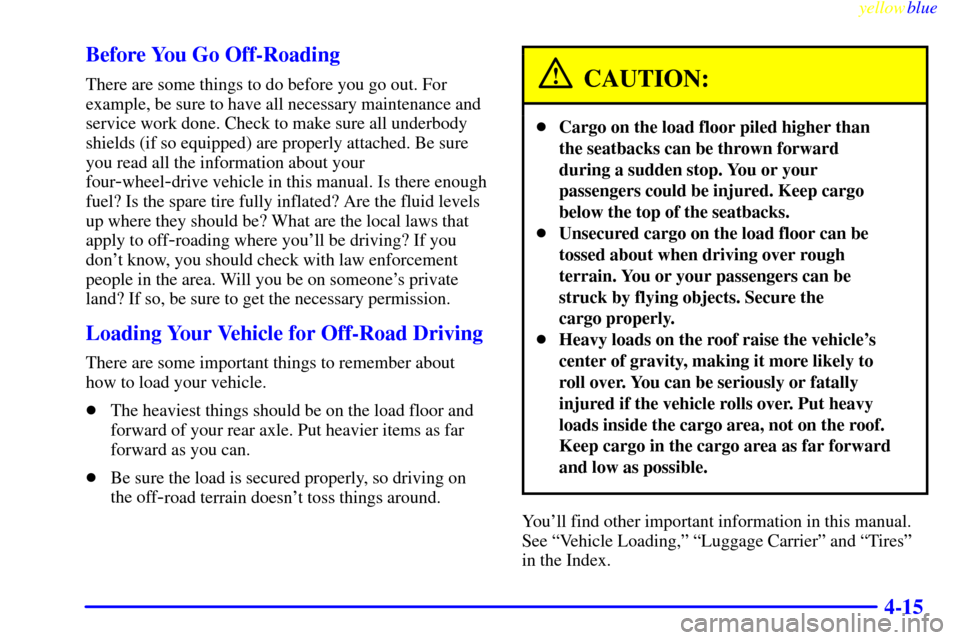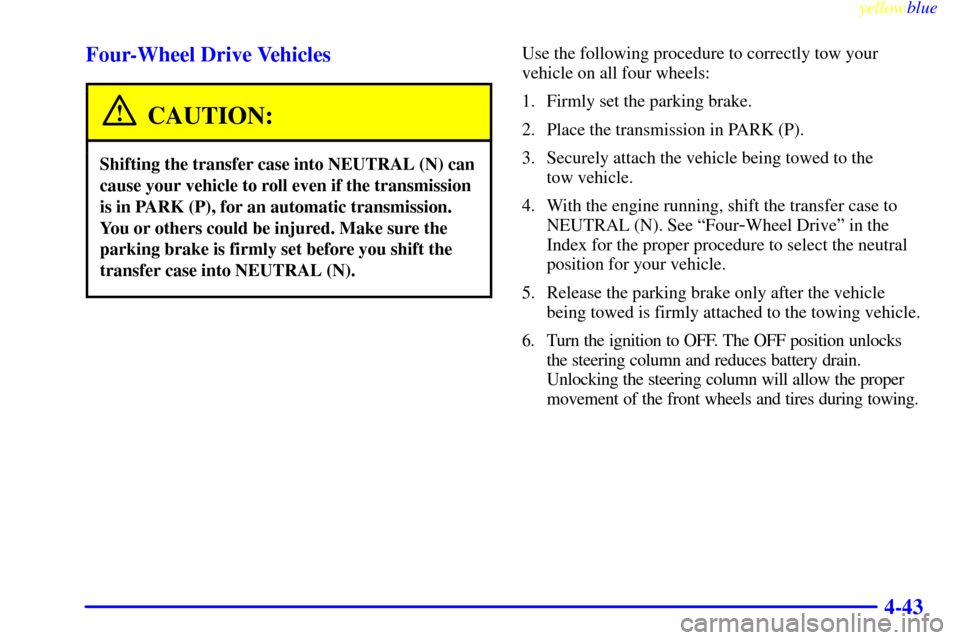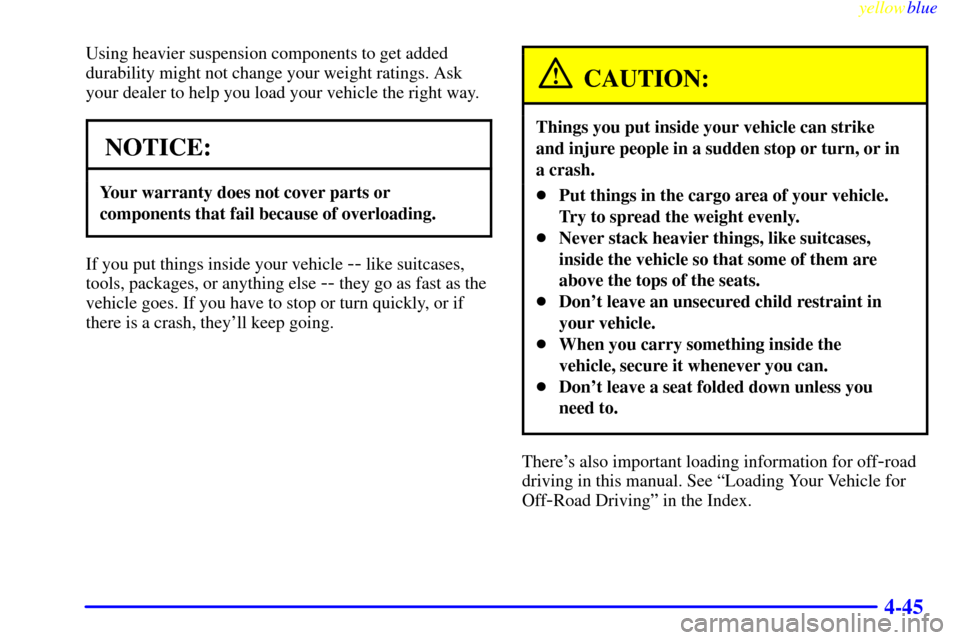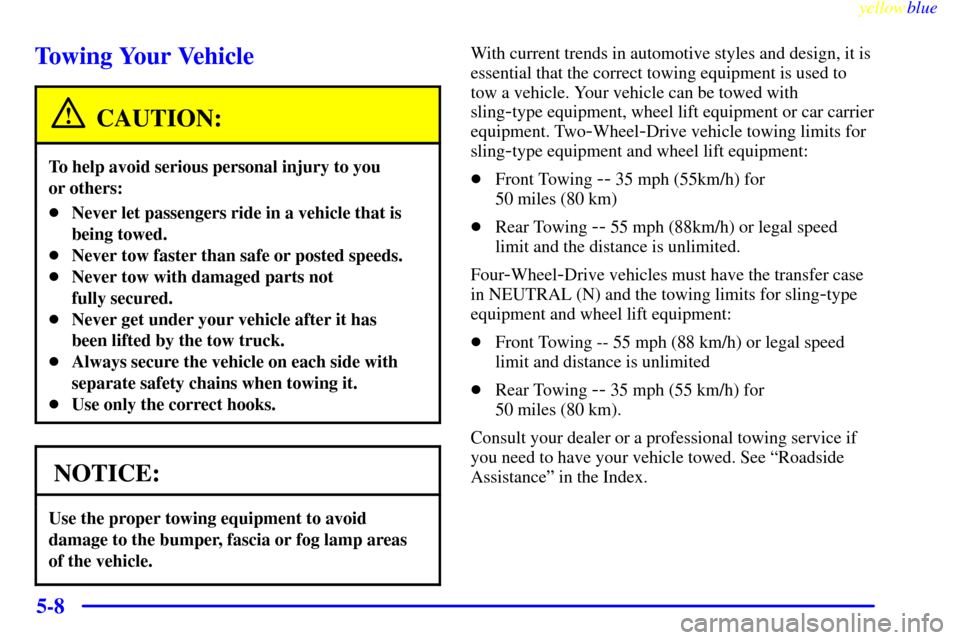Page 197 of 424

yellowblue
4-15 Before You Go Off-Roading
There are some things to do before you go out. For
example, be sure to have all necessary maintenance and
service work done. Check to make sure all underbody
shields (if so equipped) are properly attached. Be sure
you read all the information about your
four
-wheel-drive vehicle in this manual. Is there enough
fuel? Is the spare tire fully inflated? Are the fluid levels
up where they should be? What are the local laws that
apply to off
-roading where you'll be driving? If you
don't know, you should check with law enforcement
people in the area. Will you be on someone's private
land? If so, be sure to get the necessary permission.
Loading Your Vehicle for Off-Road Driving
There are some important things to remember about
how to load your vehicle.
�The heaviest things should be on the load floor and
forward of your rear axle. Put heavier items as far
forward as you can.
�Be sure the load is secured properly, so driving on
the off
-road terrain doesn't toss things around.
CAUTION:
�Cargo on the load floor piled higher than
the seatbacks can be thrown forward
during a sudden stop. You or your
passengers could be injured. Keep cargo
below the top of the seatbacks.
�Unsecured cargo on the load floor can be
tossed about when driving over rough
terrain. You or your passengers can be
struck by flying objects. Secure the
cargo properly.
�Heavy loads on the roof raise the vehicle's
center of gravity, making it more likely to
roll over. You can be seriously or fatally
injured if the vehicle rolls over. Put heavy
loads inside the cargo area, not on the roof.
Keep cargo in the cargo area as far forward
and low as possible.
You'll find other important information in this manual.
See ªVehicle Loading,º ªLuggage Carrierº and ªTiresº
in the Index.
Page 220 of 424
yellowblue
4-38
Winter Driving
Here are some tips for winter driving:
�Have your vehicle in good shape for winter.
�You may want to put winter emergency supplies in
your vehicle.Include an ice scraper, a small brush or broom, a supply
of windshield washer fluid, a rag, some winter outer
clothing, a small shovel, a flashlight, a red cloth and
reflective warning triangles. And, if you will be driving
under severe conditions, include a small bag of sand, a
piece of old carpet or a couple of burlap bags to help
provide traction. Be sure you properly secure these
items in your vehicle.
Driving on Snow or Ice
Most of the time, those places where your tires meet the
road probably have good traction.
However, if there is snow or ice between your tires and
the road, you can have a very slippery situation. You'll
have a lot less traction or ªgripº and will need to be
very careful.
Page 225 of 424

yellowblue
4-43 Four-Wheel Drive Vehicles
CAUTION:
Shifting the transfer case into NEUTRAL (N) can
cause your vehicle to roll even if the transmission
is in PARK (P), for an automatic transmission.
You or others could be injured. Make sure the
parking brake is firmly set before you shift the
transfer case into NEUTRAL (N).
Use the following procedure to correctly tow your
vehicle on all four wheels:
1. Firmly set the parking brake.
2. Place the transmission in PARK (P).
3. Securely attach the vehicle being towed to the
tow vehicle.
4. With the engine running, shift the transfer case to
NEUTRAL (N). See ªFour
-Wheel Driveº in the
Index for the proper procedure to select the neutral
position for your vehicle.
5. Release the parking brake only after the vehicle
being towed is firmly attached to the towing vehicle.
6. Turn the ignition to OFF. The OFF position unlocks
the steering column and reduces battery drain.
Unlocking the steering column will allow the proper
movement of the front wheels and tires during towing.
Page 227 of 424

yellowblue
4-45
Using heavier suspension components to get added
durability might not change your weight ratings. Ask
your dealer to help you load your vehicle the right way.
NOTICE:
Your warranty does not cover parts or
components that fail because of overloading.
If you put things inside your vehicle -- like suitcases,
tools, packages, or anything else
-- they go as fast as the
vehicle goes. If you have to stop or turn quickly, or if
there is a crash, they'll keep going.
CAUTION:
Things you put inside your vehicle can strike
and injure people in a sudden stop or turn, or in
a crash.
�Put things in the cargo area of your vehicle.
Try to spread the weight evenly.
�Never stack heavier things, like suitcases,
inside the vehicle so that some of them are
above the tops of the seats.
�Don't leave an unsecured child restraint in
your vehicle.
�When you carry something inside the
vehicle, secure it whenever you can.
�Don't leave a seat folded down unless you
need to.
There's also important loading information for off-road
driving in this manual. See ªLoading Your Vehicle for
Off
-Road Drivingº in the Index.
Page 235 of 424

yellowblue
4-53
Towing a trailer requires a certain amount of experience.
Before setting out for the open road, you'll want to get
to know your rig. Acquaint yourself with the feel of
handling and braking with the added weight of the
trailer. And always keep in mind that the vehicle you are
driving is now a good deal longer and not nearly as
responsive as your vehicle is by itself.
Before you start, check the trailer hitch and platform
(and attachments), safety chains, electrical connector,
lamps, tires and mirror adjustment. If the trailer has
electric brakes, start your vehicle and trailer moving and
then apply the trailer brake controller by hand to be sure
the brakes are working. This lets you check your
electrical connection at the same time.
During your trip, check occasionally to be sure that the
load is secure, and that the lamps and any trailer brakes
are still working.Following Distance
Stay at least twice as far behind the vehicle ahead as you
would when driving your vehicle without a trailer. This
can help you avoid situations that require heavy braking
and sudden turns.
Passing
You'll need more passing distance up ahead when
you're towing a trailer. And, because you're a good deal
longer, you'll need to go much farther beyond the
passed vehicle before you can return to your lane.
Backing Up
Hold the bottom of the steering wheel with one hand.
Then, to move the trailer to the left, just move that hand
to the left. To move the trailer to the right, move your
hand to the right. Always back up slowly and, if
possible, have someone guide you.
Page 250 of 424

yellowblue
5-8
Towing Your Vehicle
CAUTION:
To help avoid serious personal injury to you
or others:
�Never let passengers ride in a vehicle that is
being towed.
�Never tow faster than safe or posted speeds.
�Never tow with damaged parts not
fully secured.
�Never get under your vehicle after it has
been lifted by the tow truck.
�Always secure the vehicle on each side with
separate safety chains when towing it.
�Use only the correct hooks.
NOTICE:
Use the proper towing equipment to avoid
damage to the bumper, fascia or fog lamp areas
of the vehicle.
With current trends in automotive styles and design, it is
essential that the correct towing equipment is used to
tow a vehicle. Your vehicle can be towed with
sling
-type equipment, wheel lift equipment or car carrier
equipment. Two
-Wheel-Drive vehicle towing limits for
sling
-type equipment and wheel lift equipment:
�Front Towing
-- 35 mph (55km/h) for
50 miles (80 km)
�Rear Towing
-- 55 mph (88km/h) or legal speed
limit and the distance is unlimited.
Four
-Wheel-Drive vehicles must have the transfer case
in NEUTRAL (N) and the towing limits for sling
-type
equipment and wheel lift equipment:
�Front Towing -- 55 mph (88 km/h) or legal speed
limit and distance is unlimited
�Rear Towing
-- 35 mph (55 km/h) for
50 miles (80 km).
Consult your dealer or a professional towing service if
you need to have your vehicle towed. See ªRoadside
Assistanceº in the Index.
Page 264 of 424

yellowblue
5-22
If your two-door utility
model has a jack cover,
turn the wing nut
counterclockwise and
take the cover off.
To take the jack out, turn the wing nut counterclockwise
and take it and the retainer off. Take the jack and storage
box out and take the tools out of the box.
Your vehicle may have a pair of emergency gloves
secured to the jack. You can use them when changing
the tire, or during other emergency situations.
Remember to replace them with the jack, so you will
have them if needed later.
To open the jack cover on four-door utility models, turn
the wing nut counterclockwise and take the cover off.
To take the jack out, turn the wing
-head bolt
counterclockwise and take it and the retainer off. Take
the jack and storage box out and take the tools out of
the box.
Your vehicle may have a pair of emergency gloves
secured to the jack. You can use them when changing
the tire, or during other emergency situations.
Remember to replace them with the jack, so you will
have them if needed later.
Page 265 of 424
yellowblue
5-23
If your Suburban has a jack cover, lift the tab up to
release the cover, then take it off.
To take the jack out, turn the wing nut counterclockwise
and take it and the retainer off. Take the jack and storage
box out and take the tools out of the box.
Your vehicle may have a pair of emergency gloves
secured to the jack. You can use them when changing
the tire, or during other emergency situations.
Remember to replace them with the jack, so you will
have them if needed later.The tools you'll be using include the jack (A), the jack
handle extension (B), jack handle (C), wheel wrench (D)
and the ratchet (E).
The jack handle extension is used if the flat tire is on the
rear of the vehicle.